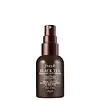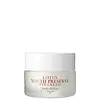What's inside
What's inside
 Key Ingredients
Key Ingredients

 Benefits
Benefits

 Concerns
Concerns

 Ingredients Side-by-side
Ingredients Side-by-side

Water
Skin ConditioningGlycerin
HumectantButylene Glycol
HumectantPentylene Glycol
Skin ConditioningJojoba Oil PEG-150 Esters
Skin ConditioningMethyl Gluceth-20
HumectantPEG-6 Caprylic/Capric Glycerides
EmulsifyingAcacia Senegal Gum
MaskingPEG-40 Hydrogenated Castor Oil
EmulsifyingLycium Chinense Fruit Extract
AntioxidantSaccharomyces Ferment Filtrate
HumectantCamellia Sinensis Leaf Extract
AntimicrobialRubus Fruticosus Leaf Extract
MaskingLitchi Chinensis Seed Extract
Skin ConditioningAcetyl Tetrapeptide-5
HumectantTocopheryl Acetate
AntioxidantTocopherol
AntioxidantPolymethylsilsesquioxane
Carbomer
Emulsion StabilisingPEG-150
HumectantSorbitol
HumectantSodium Hydroxide
BufferingParfum
MaskingRhizobian Gum
Maltodextrin
AbsorbentAlgin
MaskingXanthan Gum
EmulsifyingAdenosine
Skin ConditioningPolyvinyl Alcohol
Cellulose Gum
Emulsion StabilisingCitric Acid
BufferingSodium Metabisulfite
AntioxidantDiamond Powder
AbrasiveSodium Benzoate
MaskingPotassium Sorbate
PreservativeHydroxyethylcellulose
Emulsion StabilisingSodium Citrate
BufferingBiotin
AntiseborrhoeicPhenoxyethanol
PreservativeLinalool
PerfumingCitronellol
PerfumingGeraniol
PerfumingWater, Glycerin, Butylene Glycol, Pentylene Glycol, Jojoba Oil PEG-150 Esters, Methyl Gluceth-20, PEG-6 Caprylic/Capric Glycerides, Acacia Senegal Gum, PEG-40 Hydrogenated Castor Oil, Lycium Chinense Fruit Extract, Saccharomyces Ferment Filtrate, Camellia Sinensis Leaf Extract, Rubus Fruticosus Leaf Extract, Litchi Chinensis Seed Extract, Acetyl Tetrapeptide-5, Tocopheryl Acetate, Tocopherol, Polymethylsilsesquioxane, Carbomer, PEG-150, Sorbitol, Sodium Hydroxide, Parfum, Rhizobian Gum, Maltodextrin, Algin, Xanthan Gum, Adenosine, Polyvinyl Alcohol, Cellulose Gum, Citric Acid, Sodium Metabisulfite, Diamond Powder, Sodium Benzoate, Potassium Sorbate, Hydroxyethylcellulose, Sodium Citrate, Biotin, Phenoxyethanol, Linalool, Citronellol, Geraniol
Water
Skin ConditioningGlycerin
HumectantIsostearyl Isostearate
EmollientPropanediol
SolventSqualane
EmollientCetyl Alcohol
EmollientPotassium Cetyl Phosphate
EmulsifyingPentylene Glycol
Skin ConditioningC10-18 Triglycerides
EmollientBoron Nitride
AbsorbentGlyceryl Stearate
EmollientPolyglycerin-3
HumectantNelumbo Nucifera Extract
Skin ConditioningAesculus Hippocastanum Extract
AntioxidantCitrus Limon Peel Oil
MaskingCucumis Sativus Fruit Extract
EmollientTocopherol
AntioxidantFructose
HumectantEthylene/Acrylic Acid Copolymer
Emulsion StabilisingBis-Diglyceryl Polyacyladipate-2
EmollientBehenyl Alcohol
EmollientDimethicone
EmollientCarbomer
Emulsion StabilisingSodium Polyacrylate
AbsorbentXanthan Gum
EmulsifyingSodium Citrate
BufferingCaprylic/Capric Triglyceride
MaskingSodium Hyaluronate
HumectantCitric Acid
BufferingSodium Hydroxide
BufferingAdenosine
Skin ConditioningBiosaccharide Gum-2
Skin ConditioningSodium Metabisulfite
AntioxidantPoloxamer 338
EmulsifyingSilica
AbrasiveTetrasodium EDTA
Chlorphenesin
AntimicrobialPotassium Sorbate
PreservativeSodium Benzoate
MaskingLimonene
PerfumingCitral
PerfumingWater, Glycerin, Isostearyl Isostearate, Propanediol, Squalane, Cetyl Alcohol, Potassium Cetyl Phosphate, Pentylene Glycol, C10-18 Triglycerides, Boron Nitride, Glyceryl Stearate, Polyglycerin-3, Nelumbo Nucifera Extract, Aesculus Hippocastanum Extract, Citrus Limon Peel Oil, Cucumis Sativus Fruit Extract, Tocopherol, Fructose, Ethylene/Acrylic Acid Copolymer, Bis-Diglyceryl Polyacyladipate-2, Behenyl Alcohol, Dimethicone, Carbomer, Sodium Polyacrylate, Xanthan Gum, Sodium Citrate, Caprylic/Capric Triglyceride, Sodium Hyaluronate, Citric Acid, Sodium Hydroxide, Adenosine, Biosaccharide Gum-2, Sodium Metabisulfite, Poloxamer 338, Silica, Tetrasodium EDTA, Chlorphenesin, Potassium Sorbate, Sodium Benzoate, Limonene, Citral
Ingredients Explained
These ingredients are found in both products.
Ingredients higher up in an ingredient list are typically present in a larger amount.
Adenosine is in every living organism. It is one of four components in nucleic acids that helps store our DNA.
Adenosine has many benefits when used. These benefits include hydrating the skin, smoothing skin, and reducing wrinkles. Once applied, adenosine increases collagen production. It also helps with improving firmness and tissue repair.
Studies have found adenosine may also help with wound healing.
In skincare products, Adenosine is usually derived from yeast.
Learn more about AdenosineCarbomer is a polymer of acrylic acid. Its main role is to create a gel consistency.
A high amount of carbomer can cause pilling or balling up of products. Don't worry, most products contain 1% or less of carbomer.
Citric Acid is an alpha hydroxy acid (AHA) naturally found in citrus fruits like oranges, lemons, and limes.
Like other AHAs, citric acid can exfoliate skin by breaking down the bonds that hold dead skin cells together. This helps reveal smoother and brighter skin underneath.
However, this exfoliating effect only happens at high concentrations (20%) which can be hard to find in cosmetic products.
Due to this, citric acid is usually included in small amounts as a pH adjuster. This helps keep products slightly more acidic and compatible with skin's natural pH.
In skincare formulas, citric acid can:
While it can provide some skin benefits, research shows lactic acid and glycolic acid are generally more effective and less irritating exfoliants.
Most citric acid used in skincare today is made by fermenting sugars (usually from molasses). This synthetic version is identical to the natural citrus form but easier to stabilize and use in formulations.
Read more about some other popular AHA's here:
Learn more about Citric AcidGlycerin is already naturally found in your skin. It helps moisturize and protect your skin.
A study from 2016 found glycerin to be more effective as a humectant than AHAs and hyaluronic acid.
As a humectant, it helps the skin stay hydrated by pulling moisture to your skin. The low molecular weight of glycerin allows it to pull moisture into the deeper layers of your skin.
Hydrated skin improves your skin barrier; Your skin barrier helps protect against irritants and bacteria.
Glycerin has also been found to have antimicrobial and antiviral properties. Due to these properties, glycerin is often used in wound and burn treatments.
In cosmetics, glycerin is usually derived from plants such as soybean or palm. However, it can also be sourced from animals, such as tallow or animal fat.
This ingredient is organic, colorless, odorless, and non-toxic.
Glycerin is the name for this ingredient in American English. British English uses Glycerol/Glycerine.
Learn more about GlycerinPentylene glycol is typically used within a product to thicken it. It also adds a smooth, soft, and moisturizing feel to the product. It is naturally found in plants such as sugar beets.
The hydrophilic trait of Pentylene Glycol makes it a humectant. As a humectant, Pentylene Glycol helps draw moisture from the air to your skin. This can help keep your skin hydrated.
This property also makes Pentylene Glycol a great texture enhancer. It can also help thicken or stabilize a product.
Pentylene Glycol also acts as a mild preservative and helps to keep a product microbe-free.
Some people may experience mild eye and skin irritation from Pentylene Glycol. We always recommend speaking with a professional about using this ingredient in your routine.
Pentylene Glycol has a low molecular weight and is part of the 1,2-glycol family.
Learn more about Pentylene GlycolPotassium Sorbate is a preservative used to prevent yeast and mold in products. It is commonly found in both cosmetic and food products.
This ingredient comes from potassium salt derived from sorbic acid. Sorbic acid is a natural antibiotic and effective against fungus.
Both potassium sorbate and sorbic acid can be found in baked goods, cheeses, dried meats, dried fruit, ice cream, pickles, wine, yogurt, and more.
You'll often find this ingredient used with other preservatives.
Learn more about Potassium SorbateSodium Benzoate is a preservative. It's used in both cosmetic and food products to inhibit the growth of mold and bacteria. It is typically produced synthetically.
Both the US FDA and EU Health Committee have approved the use of sodium benzoate. In the US, levels of 0.1% (of the total product) are allowed.
Sodium benzoate works as a preservative by inhibiting the growth of bacteria inside of cells. It prevents the cell from fermenting a type of sugar using an enzyme called phosphofructokinase.
It is the salt of benzoic acid. Foods containing sodium benzoate include soda, salad dressings, condiments, fruit juices, wines, and snack foods.
Studies for using ascorbic acid and sodium benzoate in cosmetics are lacking, especially in skincare routines with multiple steps.
We always recommend speaking with a professional, such as a dermatologist, if you have any concerns.
Learn more about Sodium BenzoateSodium Citrate is the sodium salts of citric acid. In skincare, it is used to alter pH levels and acts as a preservative.
Its main functions are to maintain the pH of a product and neutralize metal ions.
The acidity of our skin is maintained by our glands and skin biome; normal pH level of skin is slightly acidic (~4.75-5.5).
Being slightly acidic allows our skin to create an "acid mantle". This acid mantle is a thin barrier that protects our skin from bacteria and contaminants.
Learn more about Sodium CitrateSodium Hydroxide is also known as lye or caustic soda. It is used to adjust the pH of products; many ingredients require a specific pH to be effective.
In small amounts, sodium hydroxide is considered safe to use. However, large amounts may cause chemical burns due to its high alkaline.
Your skin has a natural pH and acid mantle. This acid mantle helps prevent harmful bacteria from breaking through. The acid mantle also helps keep your skin hydrated.
"Alkaline" refers to a high pH level. A low pH level would be considered acidic.
Learn more about Sodium HydroxideSodium metabisulfite is also known as Sodium Pyrosulfite. It is a preservative, antioxidant, and disinfectant.
As a preservative, it helps stabilize cosmetic formulas without affecting their color or scent.
Tocopherol (also known as Vitamin E) is a common antioxidant used to help protect the skin from free-radicals and strengthen the skin barrier. It's also fat soluble - this means our skin is great at absorbing it.
Vitamin E also helps keep your natural skin lipids healthy. Your lipid skin barrier naturally consists of lipids, ceramides, and fatty acids. Vitamin E offers extra protection for your skin’s lipid barrier, keeping your skin healthy and nourished.
Another benefit is a bit of UV protection. Vitamin E helps reduce the damage caused by UVB rays. (It should not replace your sunscreen). Combining it with Vitamin C can decrease sunburned cells and hyperpigmentation after UV exposure.
You might have noticed Vitamin E + C often paired together. This is because it is great at stabilizing Vitamin C. Using the two together helps increase the effectiveness of both ingredients.
There are often claims that Vitamin E can reduce/prevent scarring, but these claims haven't been confirmed by scientific research.
Learn more about TocopherolWater. It's the most common cosmetic ingredient of all. You'll usually see it at the top of ingredient lists, meaning that it makes up the largest part of the product.
So why is it so popular? Water most often acts as a solvent - this means that it helps dissolve other ingredients into the formulation.
You'll also recognize water as that liquid we all need to stay alive. If you see this, drink a glass of water. Stay hydrated!
Learn more about WaterXanthan gum is used as a stabilizer and thickener within cosmetic products. It helps give products a sticky, thick feeling - preventing them from being too runny.
On the technical side of things, xanthan gum is a polysaccharide - a combination consisting of multiple sugar molecules bonded together.
Xanthan gum is a pretty common and great ingredient. It is a natural, non-toxic, non-irritating ingredient that is also commonly used in food products.
Learn more about Xanthan Gum